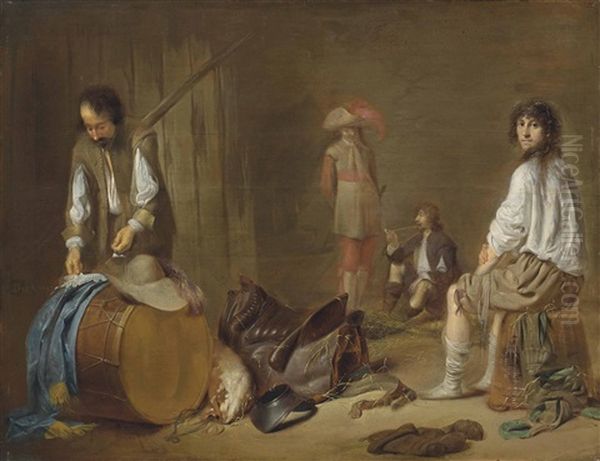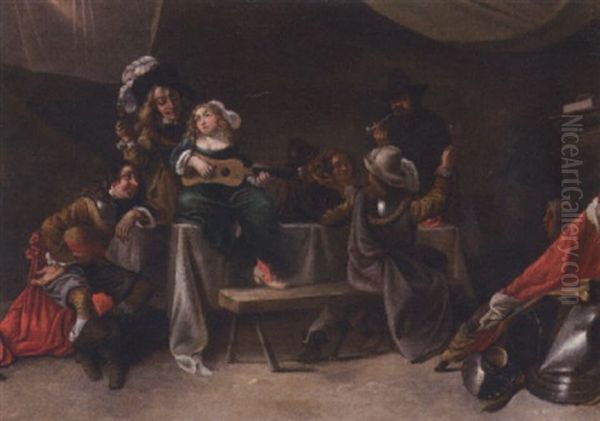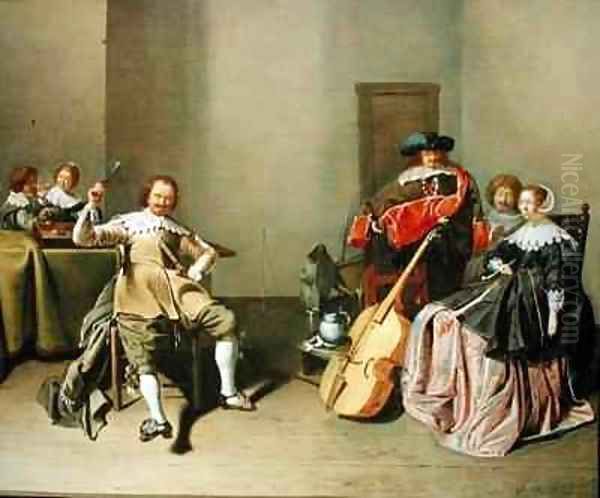The Dutch Golden Age, spanning roughly the 17th century, was a period of extraordinary artistic flourishing in the Netherlands. Amidst giants like Rembrandt and Vermeer, numerous highly skilled painters contributed to the rich tapestry of Dutch art. Among these significant figures was Jacob Duck, an artist whose work provides a fascinating window into the daily life, military culture, and social mores of his time. Though perhaps less universally known today than some of his contemporaries, Duck carved a distinct niche for himself, particularly with his lively and detailed depictions of soldiers and merry companies.
Early Life and Artistic Formation in Utrecht
Jacob Duck entered the world in Utrecht, likely around the year 1600, although the exact date remains uncertain. His initial training was not in painting but in the meticulous craft of goldsmithing. Records show he was apprenticed as a goldsmith in Utrecht in 1611. He evidently excelled in this demanding field, achieving the status of a master goldsmith in 1619. This early training in metalwork may have contributed to the precision and attention to detail often observed in his later paintings, particularly in the rendering of armour, weapons, and fine fabrics.
However, Duck's artistic ambitions extended beyond goldsmithing. In 1621, he made a pivotal decision to pursue painting, becoming a pupil of Joost Cornelisz Droochsloot. Droochsloot was a respected Utrecht painter known for his village scenes and landscapes populated with numerous figures. Studying under Droochsloot would have exposed Duck to the established traditions of Utrecht painting and the techniques required to handle multi-figure compositions.
By 1629, Jacob Duck had gained sufficient standing as a painter to be accepted as a member of the prestigious Utrecht Guild of Saint Luke. Membership in the guild was essential for artists wishing to practice professionally, take on apprentices, and sell their work within the city. This marked his official arrival as a recognized painter in the vibrant artistic hub of Utrecht.
A Career Across Dutch Cities

While Utrecht remained a primary base for much of his early career, Jacob Duck's professional life was not confined to one city. Evidence suggests he was also active in Haarlem and potentially Amsterdam at various points. Haarlem, another major artistic centre, was particularly known for its genre painting and portraiture, fields relevant to Duck's own specializations. His presence in different cities indicates a degree of mobility common among artists seeking patronage and new opportunities during this period.
His documented activity spans several decades, primarily from the 1620s until his death. He appears to have returned to Utrecht later in his life, as records indicate he was living at the St. Job's Hospital (possibly in an administrative or residential capacity, the reference to buying a "music company" there remains somewhat obscure but points to his presence) and died there, being buried on June 28, 1667. Throughout his active years, he produced a considerable body of work, primarily focusing on genre scenes.
The World of Soldiers: Guardroom Scenes (Kortegaardjes)
Jacob Duck is perhaps best known for his contributions to a specific subgenre of Dutch painting: the kortegaardje, or guardroom scene. These paintings typically depict soldiers in their off-duty hours, engaged in various activities within barracks or taverns. Duck excelled in capturing the atmosphere of these spaces, populating them with soldiers cleaning weapons, polishing armour, playing cards, drinking, smoking, sleeping, or interacting with female companions, often camp followers or prostitutes.
Works like Soldiers Arming Themselves and Soldiers in a Guardroom exemplify his mastery of this theme. He rendered the details of military attire, weaponry, and the often-cluttered interiors with great care. These scenes were not merely documentary; they often carried moralizing undertones, reflecting contemporary societal views on military life, idleness, gambling, and illicit behaviour. The interactions between the soldiers and women, sometimes playful, sometimes transactional, offered commentary on temptation and virtue.
Duck's guardroom scenes are characterized by complex compositions, often featuring multiple figures arranged in dynamic groupings within a defined interior space. He skillfully used light and shadow (chiaroscuro) to highlight certain figures or objects, drawing the viewer's eye through the scene and creating a sense of depth. The textures of metal, leather, fabric, and wood are rendered with a convincing realism likely honed during his goldsmith training.
Domestic Life and Merry Companies
Beyond the barracks, Jacob Duck also turned his attention to scenes of domestic life and "merry companies." These paintings depict groups of well-to-do burghers engaged in leisure activities – making music, eating, drinking, and conversing. A Room with Music, Eating, and Drinking is a representative example, showcasing elegantly dressed figures enjoying themselves in a comfortable interior setting.

These works share similarities with his guardroom scenes in their focus on group dynamics and detailed settings, but the atmosphere is generally more refined and less boisterous. They reflect the prosperity and social life of the Dutch middle and upper classes during the Golden Age. As with his soldier scenes, these depictions of leisure often contained subtle symbolic elements or gentle moral lessons about moderation, harmony, or the fleeting nature of pleasure, common themes in Dutch genre painting.
Diverse Subjects: Religion, Allegory, and Printmaking
While genre scenes formed the core of his output, Jacob Duck's artistic range extended further. He occasionally tackled religious subjects, such as the painting identified as Salome with the Head of Saint John the Baptist. Such works allowed him to explore more dramatic narratives and emotions, often drawing on biblical or historical sources popular during the Baroque period.
Symbolism and allegory also feature in his work. A notable example is the painting sometimes referred to as Woman in Armour or The Ironclad Woman, housed in the Centraal Museum, Utrecht. The precise meaning of such allegorical works can be open to interpretation but often relates to concepts like virtue, vice, transience, or the trials of life. The depiction of figures in unusual attire or contexts invites viewers to look beyond the surface realism.
Furthermore, Jacob Duck was not only a painter but also a skilled etcher. His prints often explored similar themes to his paintings but also included individual figure studies and perhaps more imaginative or "fantasy" subjects, like the print titled The Ironsmith's Wife. His etchings, such as Young Man in a Cloak and Hat, demonstrate his proficiency in draughtsmanship, his understanding of human anatomy, and his ability to manipulate line and tone to create effects of light and shadow in a different medium.
Artistic Style and Technique
Jacob Duck's style is firmly rooted in the Dutch Golden Age tradition of realism, characterized by careful observation and detailed rendering. His paintings often feature relatively high viewpoints and strong contrasts between light and shadow, effectively modeling figures and creating spatial depth. His palette could range from more subdued, tonal compositions to works incorporating vibrant local colours, particularly in the clothing of his figures.

His compositions are typically well-structured, guiding the viewer's eye through intricate arrangements of figures and objects. The meticulous rendering of textures – the gleam of armour, the richness of velvet, the roughness of stone walls – adds to the tactile quality and verisimilitude of his scenes. While grounded in realism, some scholars note an imaginative or even slightly theatrical element in his staging, particularly in his allegorical works or more complex genre scenes. The term "surrealism" mentioned in one source is anachronistic, but it likely points to these imaginative or non-strictly documentary aspects within his realistic framework.
Duck in the Context of the Dutch Golden Age
To fully appreciate Jacob Duck's contribution, it's essential to place him within the bustling art world of the 17th-century Netherlands. He worked during a period of unprecedented artistic production, alongside some of the most celebrated names in Western art history.
His direct teacher was Joost Cornelisz Droochsloot, linking him to the Utrecht school. However, the provided source material emphasizes a lack of direct, documented artistic connection or influence between Duck and the era's towering figures like Rembrandt van Rijn (1606-1669) or Johannes Vermeer (1632-1675). While they were contemporaries, there's no record of Duck being a pupil of Rembrandt, nor evidence suggesting he directly influenced or was influenced by Vermeer's unique style developed in Delft.
Similarly, no direct link is documented with the great Haarlem portraitist Frans Hals (c. 1582/83–1666), despite Duck possibly working in Haarlem. Nor is there evidence of direct interaction with Rembrandt's brilliant but short-lived pupil Carel Fabritius (1622–1654), who was active in Delft and is sometimes considered a bridge to Vermeer. The same applies to Jan Lievens (1607–1674), who was Rembrandt's early associate in Leiden.
While direct influence from these specific masters isn't documented in the sources provided, Duck certainly operated within the same general artistic climate. His work shares characteristics with other genre painters of the period. His guardroom scenes, for instance, can be compared to those by contemporaries like Pieter Codde (1599–1678) and Willem Duyster (1599–1635), who were also known for this subject matter, particularly in Amsterdam.
His depictions of merry companies and domestic interiors find parallels in the works of artists such as Jan Steen (1626–1679), known for his lively and often humorous scenes, albeit with a different touch than Duck's. More refined genre painters like Gerard ter Borch (1617–1681) and Gabriel Metsu (1629–1667), as well as Rembrandt's highly successful pupil Gerard Dou (1613–1675), known for his extremely detailed 'fijnschilder' technique, represent other facets of the genre painting tradition within which Duck worked.

The Utrecht context is also relevant. Although Duck's style doesn't strongly align with the dramatic chiaroscuro of the Utrecht Caravaggisti like Hendrick ter Brugghen (1588–1629) or Gerard van Honthorst (1592–1656), he would have been aware of their work, which significantly shaped the city's artistic identity earlier in the century.
Duck, therefore, stands as a distinct talent within this rich milieu, absorbing prevailing trends while developing his own recognizable style and thematic focus, particularly on the lives of soldiers.
Critical Reception, Legacy, and Unresolved Questions
Historically and critically, Jacob Duck is recognized as a significant and skilled painter of the Dutch Golden Age. His works are held in numerous prestigious international collections, including the Centraal Museum in Utrecht, the Mauritshuis in The Hague, the Thyssen-Bornemisza Museum in Madrid, the Louvre in Paris, the Metropolitan Museum of Art in New York, and museums in Helsinki, attesting to his enduring appeal and artistic merit.
Art historians value his work for its technical proficiency, particularly his handling of light, space, and texture. His paintings are also appreciated as valuable historical documents, offering insights into the social customs, fashion, and material culture of the 17th-century Netherlands, especially concerning military life. The narrative and symbolic depth found in many of his works adds another layer of interest for scholars and viewers alike.
However, some questions and minor controversies remain. The potential confusion of his identity or signature with a certain "Jan Leucq," mentioned in some sources, highlights the occasional challenges in attributing works from this period definitively. While his identity as Jacob Duck is well-established, such historical footnotes remind us of the complexities of art historical research.
Another point sometimes raised concerns the perceived consistency of his style across his diverse output. While versatility can be seen as a strength, some critics might debate the stylistic unity between his detailed genre paintings and his etchings, or across the different themes he tackled. Such debates are common in the study of prolific artists whose careers spanned several decades and involved multiple mediums.
Finally, the influence of his personal background, such as his Catholic faith in a predominantly Protestant nation, on his art remains an area that could warrant further exploration. While his subject matter is largely secular genre painting, the underlying moral or symbolic messages might potentially reflect aspects of his personal beliefs or the specific cultural context of Catholic communities in Utrecht, though this is not explicitly detailed in the provided sources.
Conclusion: Chronicler of Golden Age Life
Jacob Duck emerges from the historical record as a talented and productive artist who made a distinctive contribution to Dutch Golden Age painting. His meticulous training as a goldsmith provided a foundation for the detailed realism that characterizes his work. Specializing primarily in genre scenes, he became particularly noted for his lively and insightful depictions of soldiers in guardrooms, capturing both the camaraderie and the potential vices of military life.
His repertoire extended to scenes of domestic leisure, religious and allegorical subjects, and accomplished printmaking, showcasing his versatility. While perhaps not reaching the revolutionary heights of Rembrandt or the enigmatic intimacy of Vermeer, Jacob Duck was a master in his own right, skillfully chronicling the varied facets of 17th-century Dutch society. His paintings continue to engage viewers with their technical finesse, narrative interest, and glimpses into a world both familiar and distant. He remains an important figure for understanding the breadth and depth of artistic achievement during one of the most remarkable periods in art history.